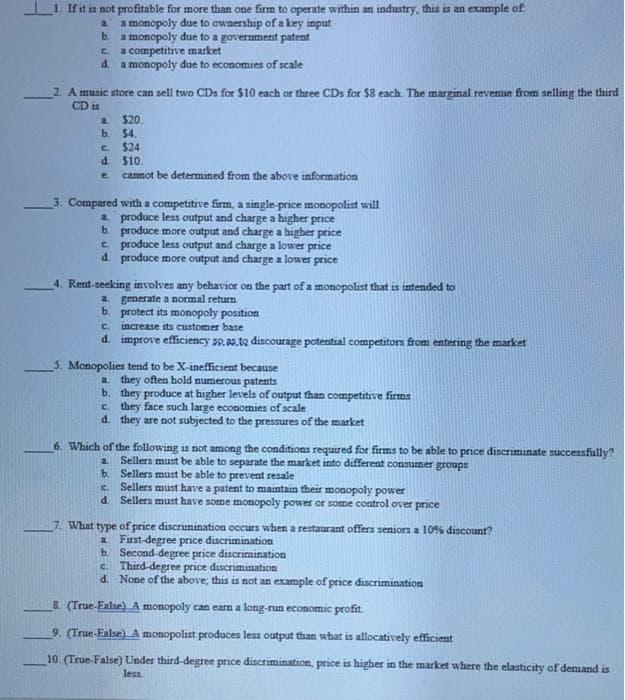1. If it is not profitable for more than one firm to operate within an industry, this is an example of. a a monopoly due to ownership of a key input b. a monopoly due to a government patent C. a competitive market d. a monopoly due to economies of scale
1. If it is not profitable for more than one firm to operate within an industry, this is an example of. a a monopoly due to ownership of a key input b. a monopoly due to a government patent C. a competitive market d. a monopoly due to economies of scale
Chapter25: Monopoly
Section: Chapter Questions
Problem 16E
Related questions
Question
! solved all parts

Transcribed Image Text:I1. Ifit is not profitable for more than one firm to operate within an industry, this is an example of
a monopoly due to ownership of a key input
b. a monopoly due to a government patent
C. a competitive market
d. a monopoly due to economies of scale
a.
2. A music store can sell two CDs for $10 each or three CDs for S8 each. The marginal revenue from selling the third
CD is
a $20.
b. $4.
$24
d. $10.
e cannot be determined from the above information
C.
3. Compared with a competitive firm, a single-price monopolist will
a. produce less output and charge a higher price
b. produce more output and charge a higher price
e produce less output and charge a lower price
d. produce more output and charge a lower price
4. Rent-seeking involves any behavior on the part of a monopolist that is intended to
a generate a normal return
b. protect its monopoly position
C.
increase its customer base
d. improve efficiency sp.as.to discourage potential competitors from entering the market
5. Monopolies tend to be X-inefficient because
a they often hold numerous patents
b. they produce at higher levels of output than competitive firms
c. they face such large economies of scale
d. they are not subjected to the pressures of the market
6. Which of the following is not among the conditions required for firms to be able to price discriminate successfully?
Sellers must be able to separate the market into different consumer groups
b. Sellers must be able to prevent resale
c. Sellers must have a patent to maintain their monopoly power
d. Sellers must have some monopoly power or some control over price
7. What type of price discrimination occurs when a restaurant offers seniors a 10% discount?
a First-degree price discrimination
b. Second-degree price discrimination
c. Third-degree price discrimination
d. None of the above; this is not an example of price discrimination
8. (True-Ealse) A monopoly can earn a long-run economic profit.
9. (True-Ealse) A monopolist produces less output than what is allocatively efficient
10. (True-False) Under third-degree price discrimination, price is higher in the market where the elasticity of demand is
less.
Expert Solution
This question has been solved!
Explore an expertly crafted, step-by-step solution for a thorough understanding of key concepts.
This is a popular solution!
Trending now
This is a popular solution!
Step by step
Solved in 2 steps

Recommended textbooks for you


Microeconomics: Principles & Policy
Economics
ISBN:
9781337794992
Author:
William J. Baumol, Alan S. Blinder, John L. Solow
Publisher:
Cengage Learning

Principles of Economics 2e
Economics
ISBN:
9781947172364
Author:
Steven A. Greenlaw; David Shapiro
Publisher:
OpenStax


Microeconomics: Principles & Policy
Economics
ISBN:
9781337794992
Author:
William J. Baumol, Alan S. Blinder, John L. Solow
Publisher:
Cengage Learning

Principles of Economics 2e
Economics
ISBN:
9781947172364
Author:
Steven A. Greenlaw; David Shapiro
Publisher:
OpenStax